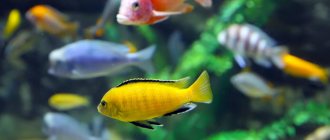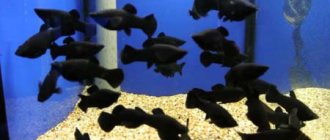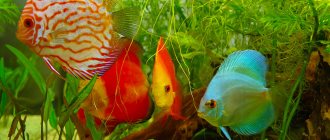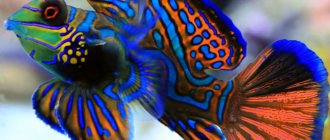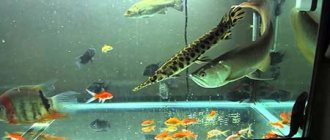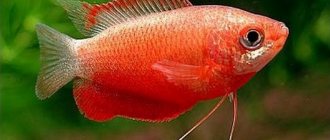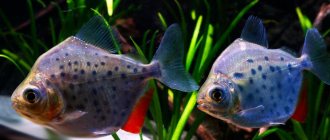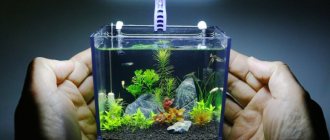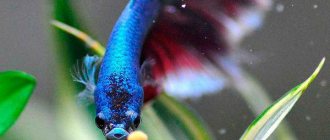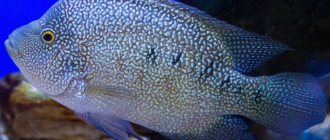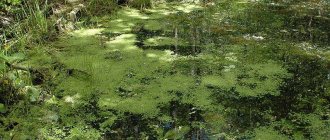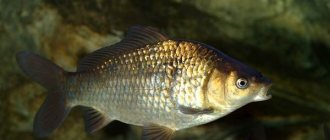Aquarium cichlids are inhabitants of the underwater world of amazing beauty and intellectual abilities. They are difficult to care for, and they will decorate a pond only for an experienced aquarist. Their rich color often makes them mistaken for sea fish, but such a “pseudo-sea” will only be an advantage of a rich interior.
- 1 History of the species
- 2 Description and habitat
- 3 Varieties of cichlids 3.1 South American cichlids
- 3.2 Cichlids of Africa
- 3.3 Asian cichlid species
History of the species
Cichlids are a large family of ray-finned fish belonging to the order Perciformes. There are about 3 thousand different species in the world with body sizes ranging from dwarfs, barely reaching 2.5 cm, to meter-long individuals.
Some varieties are commercial, for example, tilapia, others are widespread in the aquarium hobby - Oscars, angelfish, discus.
Despite the fact that aquarists’ serious fascination with these beautiful inhabitants of the underwater world began not very long ago, African cichlid tilapia were first bred in artificial reservoirs in Ancient Egypt and Assyria many thousands of years ago.
Koi carp
Koi carp are peaceful large fish, although they will eat smaller slow-moving fish. They grow up to 90 cm in size. They live on average 20-30 years, but under good conditions they can live 50 years. With age, they begin to recognize their owners, and if you teach them, they will take food from your hands. To keep koi carps, you need a tank with a depth of at least 1 meter, and for one fish the volume of water should be 100 - 180 liters. They are more often kept in home ponds and swimming pools than in home ponds. Koi can live in a wide variety of water conditions.
Description and habitat
Cichlids live on almost all continents of the world, with almost half of the species found in two unique lakes in Africa - Tanganyika and Malawi (Nyasa), which can be called a natural laboratory. Over millions of years of development, from the few fish that found their way into these ancient bodies of water, multiple species evolved.
Cichlids are most often territorial varieties of perciformes, varying significantly in size and shape depending on their habitat, and are usually quite hostile. They prefer fresh water, but they also thrive in salt water.
The main species of cichlids have a rounded, tall body, slightly flattened on the sides, with a large head and a mouth with well-defined lips. As males grow older, a fatty growth appears on their forehead.
Most varieties are monogamous, choosing one partner for their entire long life (from 10 to 25 years).
Photo gallery of cichlids:
For aquaculture enthusiasts, this is mostly a complex fish; only some species are quite unpretentious, for example, black stripe, meeka, and angelfish.
The lifespan of cichlids is determined by their habitat; at high water temperatures, metabolism and biorhythm accelerate. In cool (to a certain limit) fish live longer.
Aquasalons usually sell teenage cichlids, their age is about 2-6 months. Young animals have a paler color, smaller body and fins, and their sexual characteristics are not clearly expressed.
Cichlids of South America
They inhabit the vast basin of the Amazon River and some other river systems of the tropical and equatorial belts flowing into the Atlantic Ocean. They inhabit small streams and channels flowing under the canopy of the rain forest. The typical habitat is shallow ponds with a slow current, littered with fallen vegetation (leaves, fruits), tree branches, and snags. As organic matter decomposes and tannins are released, the water acquires a characteristic “tea” hue.
Varieties of cichlids
The cichlid family, despite their ubiquity, is usually divided into three large classes:
- South American - prefer soft water;
- African - love habitats with medium and high rigidity;
- Asian is the smallest class.
They include many species that differ somewhat in shape, size and behavior.
South American cichlids
Of these, the following varieties are especially popular.
Akary
These fish are small to medium sized cichlids. Quite peaceful ones are known among cancers, for example, the bluish-spotted one, and, conversely, even overly hostile species (turquoise).
Spotted Acara is found in the natural environment in calm waters of Panama and Colombia. At the beginning of the 20th century, this fish was brought to Europe and Russia by professional aquarists.
In artificial reservoirs it grows up to 5-7 cm, in nature it is much larger (about 15 cm).
The flattened tall body has a rounded shape, the grayish color of the skin is practically invisible under the greenish-golden scales. There are large dark marks and several vertical stripes on the sides. The gills are covered with an intricate blue pattern. The dorsal fin has a pink border in males, and a white border in females.
These fairly peaceful fish can be safely kept with other species.
Nannakar anomalies
The natural habitat of this species is the small reservoirs of Guiana. Introduced to Europe and Russia in the mid-20th century.
The fish are small - the size of females rarely reaches 3 cm, males are larger - up to 8 cm. Males are painted in turquoise tones with a scattering of dark marks, and a blue pattern is visible on the gills. The fins on the back have a green-blue tint, the belly fins are lemon and green, and the fins on the chest are transparent.
Females are not so bright, yellow in color with dark stripes along the sides. They behave quite calmly in the aquarium, but during the spawning period they become simply uncontrollable, even attacking other cichlids. At this time, they should be placed in a special spawning tank with abundant greenery.
Apistograms
These South American cichlids form a very large species that includes various subspecies. The most popular Apistograms are Ramizer, Kakadu, Two-Stripe, Panda, Hongslo.
Ramizer
They live naturally in the reservoirs of Venezuela. European and Russian aquarists began propagating them in an artificial environment in the 60s of the last century. They belong to the dwarf cichlid breeds; a rare individual reaches a size of 5 cm.
A tall, flat body of a yellowish color with a greenish or purple tint, with the same spots on the sides. There is a bright dark mark on the stomach, and two vertical stripes of the same color on the head between the large eyes. Males are larger than the brighter females, whose abdomen is usually purple-scarlet.
This species is absolutely non-aggressive and can get along with any aquarium inhabitants.
Cockatoo
Sometimes they grow up to 7 cm. They have a bright color, dominated by red, orange and gold tones. The dorsal fin resembles a fancy mottled scallop. These fish are quite angry.
Altispinosa or Bolivian butterflies
The most unpretentious representatives of this species, very bright and colorful, compatible with other fish. One of the few subspecies of cichlids that can be practiced by a novice aquarist.
Two-way or Biteniates
Small (up to 7 cm) and very active fish, beautifully colored with a characteristic dark stripe along the sides. Males are larger and brighter than females. Usually the main background is yellow, and the fins have a blue tint. It lives naturally in the rivers of Peru, Bolivia, and Brazil. Omnivorous and unpretentious in maintenance.
Panda
A very beautiful and small (up to 8 cm) fish that lives in the basin of two rivers in Peru - the Ucayali and Yavari. The color is yellow throughout the body and fins with dark markings, often in the form of vertical stripes near the head and a bluish tint. Carnivorous, but unpretentious in care.
Hongslo
Small, predatory and very bright fish. In nature, they live in the reservoirs of Colombia and Venezuela. Females are about 4 cm, males - 6 cm. They are brighter and more powerful, the color is dominated by reddish-yellow and orange tones. The fins are high-standing, sharp along the edge. In nature, they usually eat bottom invertebrates, but in an aquarium they are omnivorous and quite calm when there is an abundance of food. Monogamous, it is better to keep them as a pair or a small harem.
Cichlazomas
They have elongated slender bodies, sometimes reaching a length of 15-17 cm. There are many subspecies of them - Black-striped, Flamingo, Meeks, Festums, Peaceful, Yellow. All of them are distinguished by the presence of bright stripes or spots on the body.
Black-striped cichlazomas live in small lakes in Guatemala. In Europe and Russia, they began to successfully select this species in the 60s of the 20th century.
The body is rather gray in color with multiple (up to 9) black stripes arranged vertically, often because of this they are called Zebras. Females are slightly smaller than males with a more contrasting pattern and an orange belly. They are quite unpretentious and calm, but prefer large bodies of water with abundant vegetation.
Angelfish
Perhaps this is the most common variety of cichlids; they appeared in European aquariums already in 1909. In nature, they are numerous in the slow and wide rivers of South America.
They have a characteristic large body shape, resembling a crescent, a modified triangular shape, with long and voluminous fins. The native color - white with black stripes - is now rare in aquariums; there are many brightly colored breeds obtained through breeding. They differ in color, various body shapes and fins. Very peaceful and unpretentious inhabitants of reservoirs, they are loved by both beginners and professionals.
Discus
These fish are rightfully considered one of the most expensive and even elite. It is very difficult to maintain them so that you can admire the aquarium for hours. They are capricious both in terms of food and living conditions. In addition, they are very unstable to stress.
Its natural habitat is the calm waters of the Amazon. They appeared in Europe in the 30s of the last century, and the first experience of successful artificial breeding dates back to the 60s.
They have a large, almost round, flattened body (up to 20-25 cm). The color of natural species is bright brown with vertical dark stripes (there are 9 of them) and a greenish tint. Selected species of different colors - red, yellow, pink, white, blue.
These are peaceful fish, but for successful keeping it is better not to add other species to them.
The most famous breeds of discus are Heckel, Pigeon Blood, Leopard, Green, Cobalt, Marlboro, Blue Diamond, Snakeskin, San Mera, Red Melon, Red Card.
Astronotuses
Large cichlid species (up to 25 cm), living in nature most often in the waters of the Amazon. In the aquarium hobby, their widespread use began only in the 50-60s of the last century.
The main tone of the slightly elongated body is usually grayish-gray, but it can also have a yellow tint. The fairly large scales are scattered with golden markings in the form of spots and lines. Selection has made it possible to develop various color variations, but black and white and orange are more common.
Astronotuses are capable of digging up the entire soil, displacing the scenery. You cannot house peaceful fish with them, only similar predators.
Geophagus altifronsa
They have elongated massive bodies up to 20-22 cm. They live in the natural environment mostly in the Rio Negro River basin, they love lowlands and muddy floodplains, but with clean water.
Color ranges from yellow-orange to bluish. Large head with elongated lips. Sexual dimorphism is practically not developed; male and female individuals are very difficult to distinguish.
Peaceful and unpretentious inhabitants, they prefer to live in a flock of 5-8 individuals. Suitable for beginner aquarists.
Cichlids of Africa
This group is also diverse.
Handsome chromis
These small cichlids were introduced to Europe and Russia at the beginning of the 20th century. The maximum body size of aquarium species is 12 cm. The usual color is brown-red, and the spawning period becomes bright scarlet with iridescent greenish spots.
Keep only separately from other fish.
Celmatochromis pulchera
In nature, they live in tropical waters of West Africa. They appeared in European countries in the middle of the last century.
They have a variegated color with a greenish-golden background, a black back and a longitudinal graphite stripe on the sides. The plumage is dotted with dark markings, and on the belly there is a scarlet spot, better expressed in females.
Moderately hostile species, can be kept with fish of similar character.
Labidochromis yellow
Endemic to the African Lake Malawi, its description appeared in 1958.
The main color is bright golden with thin black edging on the fins.
Some varieties can show restrained aggression, but it is best kept only in species aquariums.
Haplochromis venustus
These cichlids are also an endemic species of Lake Malawi.
In captivity they grow to 25 cm or more. They have a golden-olive color with light markings throughout the body. This pattern is more contrasting in females; there are blue dots on the gills and fins.
Very smart hunters, attacking prey from bottom sludge, having previously buried themselves in it. You should not house them with other fish.
Melanochromis auratos
Another representative of Malawian hunters. Auratos have very pronounced sexual dimorphism - males are rather black with a white stripe on the sides, females are light in color with a graphite line along the entire body. Aggressive, kept only in cichlids.
Melanochromus aureus
These South African cichlids are large, beautiful predators. They are painted in golden tones, contrasting with the graphite fins.
Blue dolphins
The body shape of this underwater inhabitant of African lakes really resembles a dolphin. The color is light with a silvery-bluish tint. Peaceful and friendly fish, unpretentious in maintenance.
Red Devil
Cichlazomas labiatum are distinguished by a very exotic appearance and bright coloring, undemanding conditions of detention, and high endurance. But they weren’t called devils for nothing; they are extremely quarrelsome.
They are an endemic species of the tectonic lakes of Nicaragua and Managua, united by the underground Tipitapa River. A very large species, some individuals reach a length of 35 cm. Males are larger than females and have a pronounced occipital growth. The color of the scales ranges from soft lemon to bright orange.
Suitable only for keeping in a species aquarium.
Princess of Burundi
Cyclida Fairy is named after the name of the area where it was first discovered on the coast of the lake.
The most popular fish of Lake Tanganyika. Quite calm, if the size of the artificial reservoir is large, it is able to get along with other fish. It is better to keep 2-3 females with one male.
They are distinguished by their small size (up to 9 cm), weak sexual differences between males and females, gray-yellow colors, high fins with a bluish tint along the edges.
Dimidochromis
A very bright and beautiful predator, whose color is dominated by orange and blue tones. The head is large with powerful jaws.
It is endemic to Lake Malawi. In a large species aquarium it can get along with other large aggressive fish. It is difficult to keep at home, since the size of the smallest individual exceeds 25 cm.
The body is large but flat, it is the most flattened cichlid of Malawi. Males are metallic blue with bright orange fins, females and juveniles are rather simply silver.
Zebra Mbuna
One of the most hostile fish in Lake Malawi. Suitable for keeping in a species aquarium only.
"Mbuna" means "cliff dwellers", which describes the favorite habitats of this species.
A small fish (7-9 cm) has a large convex head and high-standing fins, pointed at the edges. There are a variety of colors - charcoal white, orange, blue-black, but the most common are blue and light blue tones with vertical stripes of the same color, but more saturated.
Queen of Tanganyika
The zebra lobed cyphotilapia or Frontosa is endemic to East Africa's Lake Tanganyika. It usually settles at very great depths (up to 70 m) along the rocky coastline. This is an insidious predator that, in a species aquarium, if there is sufficient food available, behaves quite peacefully.
A strong body up to 25 cm long has a large head with a characteristic growth on the forehead; it is more pronounced in males. Otherwise, sexual dimorphism is not developed. The main background is light, it is crossed out by wide dark stripes, making the fish really look like zebras. The sharp fins are colored in blue and bluish tones.
Asian cichlid species
There are only two naturally occurring species of cichlids thought to be found in the Asian region, but there are several others that overlap with the South American ones, such as the Oscars.
Spotted etroplus
Inhabitants of fresh and brackish waters of Sri Lanka and India.
Small fish, the maximum size of which rarely reaches 9 cm. Sexual dimorphism is weakly expressed, but males are slightly larger and brighter. They are quite peaceful and do not like to dig up the soil. Some aggression is shown during the period of caring for the fry.
The juveniles are very beautiful, the head is large with such large eyes that they seem to occupy its entire area. The main color is deep brown, and the chest is bright orange.
Green etroplus
Also common in water bodies of India and Sri Lanka, where they grow to almost half a meter in length.
In an aquarium, at 10-12 cm they already reach sexual maturity, growing to a maximum of 30 cm. They have a greenish color of scales and fins.
They are quite calm and peaceful, but they eat all aquatic plants.
Oscars
A very popular aquarium fish, which includes many subspecies with different fin shapes and scale colors.
They are found in nature in South and even North America, but an Asian species that lives in the reservoirs of Singapore is also known.
This is a fairly large fish, up to 35 cm long. The dark background color is colored with bright red spots. The high fins are black. This coloring is characteristic of natural species; breeding species are distinguished by a wide variety of colors.
After the Gulf War, many natural species of Asian cichlids were on the verge of extinction, so African tilapia are now introduced into reservoirs.
Multiple aquarium varieties of Asian cichlids have been bred based on natural isomorphs - Israeli Tilapia, Nile, Mango, Redberry, Ironocyclagordonsis, Green Chromide.
Cichlazoma diamondata
The body of the diamond cichlazoma is strewn with bluish scales, thanks to which it seems that the fish is strewn with diamonds. In nature, the cichlid lives in North America, in the state of Texas and the northern part of Mexico, so it has another name - Texas cichlid. The body of the diamond cichlazoma is large, wide, oval-shaped, up to 30 cm in length. Lives in an aquarium for 10-15 years. It feeds on a wide variety of foods: worms, insects, crustaceans, plant foods. An aggressive, territorial aquarium fish with a bad character and often outrageous behavior: it often quarrels with its neighbors, is belligerent towards them and can create a mess in any, even the most beautiful aquarium - it loves to dig the soil. The diamond cichlid is often said to be a true Texan.
Mr. Tail Recommends: Cichlid Aquarium Basics
Even if only cichlids are stocked in the aquarium, it is very interesting to observe their behavior. These fish amaze not only with the beauty of their coloring, but also with their active social life, high intelligence and touching care for their offspring.
The most common cichlids kept in home aquariums are angelfish, discus, melanochromus, oscar, chromis, and cichlas. Among these species there are individuals that differ significantly in size, shape of the body and fins, and type of nutrition - these are omnivores and predators.
But the general requirements for keeping cichlids are the same:
- They need spacious tanks with a capacity of at least 60 liters, and preferably 300-400 liters.
- It is necessary to provide for the organization of grottoes, caves, driftwood, which will have not only a decorative, but also a protective function.
- It is better to house cichlids in pairs or small families, where there are 2-3 females per male.
- Optimum temperature +27…+28 °C.
- Regular changes of a third of the water should be done at least 2 times a week.
- It is mandatory to install powerful, preferably remote, filters and an aeration system.
- It is better to install a special lid with an artificial lighting system on the tank.
Experienced aquarists believe that the best cichlid is a bare stone wasteland, and it is better to install artificial plants, since live ones will be eaten instantly.
But for some species of cichlids, such as apistogramma and parakeets, you can organize a real underwater garden. Only in this case is it important to correctly zone the reservoir, creating areas of grottoes and thickets there, as well as free space for the active movement of individuals.
Zoning is very important for group keeping, for example, angelfish, since each pair occupies its own territory, which it actively protects.
Vallisneria, which, when growing, creates a kind of screen-thickets, is well suited as a plant for these species of cichlids.
For Malawian cichlid species, it is a good idea to float duckweed on the surface of the water as natural feeding. Decorative grottoes, coconut halves, driftwood, pots and amphorae also help with zoning. The soil is not so important; cichlids are indifferent to it. Lighting in an artificial tank should be moderate, in cool colors.
Accommodations
Cichlids, despite their different origins and appearance, require similar living conditions. In nature, African, American, and Asian cichlids live in reservoirs that have the same water parameters.
Aquarium volume
Cichlids require a spacious aquarium, are active and can be aggressive due to territorial issues. Based on their size and behavior, a tank is selected.
It is recommended to divide the aquarium for cichlids into zones with different landscapes:
- area with plants;
- a place for digging the soil - so that fish do not dig in areas with vegetation;
- area with shelters - cichlids love to hide and be secluded.
The number of zones depends on the number of fish. If there are 4 individuals in the aquarium, then the number of zones is doubled. Otherwise, the cichlids themselves will divide the aquarium in half.
Aquarium parameters:
- volume - 50-500 l (for a pair of cichlids);
- length - 100-130 cm;
- A lid is required.
The volume of the aquarium depends on the size of the cichlids, which come in dwarf, medium and large sizes.
Water
Cichlids in American reservoirs prefer soft water with a low pH level. Their African counterparts are divided into two groups. The first is river cichlids, the content of which is almost the same as that of American cichlids.
The second group of African cichlids is from the African Great Lakes. They need hard alkaline water. Regardless of the species, all cichlids love warmth and can tolerate water salinity of up to 50%.
Recommended water parameters (suitable for most species):
- temperature - +23...+26°С;
- hardness (carbonate) - 5-8°dKH (up to 20°dKH for East African cichlids);
- acidity (pH) - 6.0-7.5 (pH up to 8.5 for East African cichlids).
In nature, cichlids spend most of their time in the middle layers of water. The temperature difference between seasons is more than 20°C. Such a life hardened the cichlids and developed in them excellent adaptation abilities.
Change the water at least once a week, preferably a couple of times, since cichlids produce a lot of waste. The minimum volume of replaced water is 25%.
Priming
When choosing soil, it is important to take into account the behavioral characteristics of cichlids. Most species prefer to spend time rummaging in the ground, because of this it is contraindicated to use fine sand in the aquarium - so that the fish do not raise turbidity in the water.
Suitable soil options:
- Coarse river sand - it is quite dense, so waste will collect on its surface. They can be easily removed using a siphon.
- Small rounded pebbles - they need to be siphoned regularly, as dirt accumulates between the pebbles.
- Baked clay soil - Tetra ActiveSubstrate can be purchased at a pet store.
- Others - you can also use coral or marble chips or ground shells as soil.
Soil for cichlids should consist of fractions that do not have sharp edges. Otherwise, the fish, rummaging in it, will injure their thick lips. The recommended layer thickness is from 4 to 6 cm.
Plants
The vast majority of cichlids are incompatible with aquatic plants. Some fish completely eat the stems of algae, while others dig up their roots while digging in the ground.
There are several ways to solve the problem with plants:
- plant species with hard leaves and strong roots;
- plant plants in special pots;
- replace living plants with artificial ones;
- stop planting altogether.
The most loyal to plants are dwarf species and cichlids with a naturally calm character - angelfish and apistogramma. Anubias can be planted in an aquarium with these fish. They have hard leaves, and most importantly, the plants grow well even without rooting in the ground.
Lighting
Lighting is recommended to be moderate and diffused. It is forbidden to place an aquarium with cichlids in direct sunlight. The best option for arranging lighting is to install a special aquarium lid with artificial light.
In an aquarium with cichlids, be sure to install a filter, compressor and thermostat.
If there are plants in the cichlid, select the lighting taking into account their needs, since cichlids are not particularly important to light, just like the plants themselves. Recommended lighting settings:
- light temperature - 6000-6500 K;
- spectrum - to stimulate the growth of living plants;
- daylight hours - 8-12 hours.
If there are no plants in the aquarium, lighting is created to highlight the beauty of the fish. The light should be on for no more than 5 hours a day. Recommended luminaires: Tetra LightWave Complete Set.
Compatibility
Before purchasing cichlids, it is necessary to thoroughly study the characteristics of this species, as many of them cannot be placed in one tank due to their uncooperative nature. Some have a preference for plants, others will actively eat their neighbors, although most breeds are only aggressive during the spawning period.
It is unwise, for example, to keep several male parrot cichlids together, since one will definitely be the leader and will not calm down until he gets rid of the rest of his brothers.
The best condition for cichlids to live in an artificial reservoir is to organize a species aquarium, where certain natural pictures of South American, African or Asian underwater flora and fauna are recreated.
It is unwise to populate an artificial reservoir with these aggressive inhabitants and other peaceful species. But angelfish, for example, are much calmer than other cichlids; they can be combined with swordtails, mollies, platies, gourami, zebrafish, cockroaches, and corydoras.
Angelfish [Pterophyllum]
With all the variety and color of aquarium inhabitants, the angelfish remains one of the most beautiful fish for the home aquarium. The homeland of the angelfish is South America, the Amazon River basin, where they live in slow-flowing rivers with abundant vegetation. The generic name of this fish is translated as winged leaf. In the West it is more often called angel fish...
An aquarium is a stylish, beautiful piece of furniture that attracts the attention of people in the room and fills them with peace and tranquility. Inside it there is an amazing world, radically different from ours. An activity like keeping fish in an aquarium is pleasant and useful at the same time. It is very interesting to care for the inhabitants of an indoor aquarium, to watch how they grow and reproduce. This activity allows you to relieve stress, relax, and take your mind off tedious tasks and worries.
Feeding
The diet of cichlids varies quite a lot depending on the specific species. For herbivores, it is preferable to feed chopped lettuce, spinach, dandelion, cucumbers, carrots, zucchini, and spirulina tablets.
Predators need protein food - finely chopped squid, fish, beef, shrimp, live food. You also need to remember that a pair of African cichlids may completely refuse to eat during the incubation period of carrying eggs in the mouth (from 15 to 40 days).
When keeping all cichlids, it is better to adhere to the rule of the golden mean - the fish diet should be complete, of high quality and properly balanced. For predators, the content of by-products (meat, seafood) should be minimal; it is better to give preference to live (bloodworms, Artemia nauplii, cortera) and ready-made industrial feeds.
The Mbuna group of cichlids belongs to phytophages and in their diet up to 70% of food should be of plant origin and only 30% protein. It is most profitable to grow duckweed as a live feed, as it reproduces very quickly.
All cichlids are not picky and eat dry daphnia and gammarus well.
Twice a week you can feed them a homemade delicacy. To do this, take a frozen bovine or beef heart, cut off the fat and films from it, finely chop or grate it and freeze it in small portions.
How to get rid of aquarium snails
In small doses, aquarium snails are cute and darling, helping to clean the jar and maintain biobalance. But no one can control the birth rate of gastropods without tricks. Several time-tested techniques will come to the rescue:
- Catch an enemy with your hands. This is the simplest method and is suitable for large species that do not reproduce so quickly. For example, it is completely useless against coils.
- Make a trap. This method is perfect for coils. You just need to attach a lettuce leaf to the fishing line and lower it into the aquarium in the evening. Turn on the light at night and you will see that the snails in your aquarium are like stars in the galaxy. You need to pull out the sheet and do with the catch as you please. Of course, you will not get rid of all the gastropods, but if you regularly repeat this operation, then in this way you can regulate the number. A trap for aquarium snails can be made with your own hands and in the form of a plastic bottle, glass, etc., filled with snail food.
Video: how to make a snail trap
- Restart the aquarium. This is a troublesome task, but sometimes useful. The fish move, the soil boils, the glass is washed, the plants change (but this is not a guarantee, as you remember).
- Cheat up. Almost all types of snails die when preparations containing copper are added to the water. But this is an extremely risky step, because not only can other inhabitants die, but you also do not completely remove all the shells with decomposing contents.
- Launch the cannibals. I'm not kidding. There is one species - Helena - that feeds on its relatives. And this is really a way out, because with a low reproduction rate, helenas tirelessly suck prey out of the shell with their proboscis. The only thing is that Helens cannot have breakfast with a larger snail than themselves, but you yourself can easily get them out of the water. With a lack of natural prey, Helena easily switch to other types of food: they eat dead fish and fish food. You can even specially throw them some coils - the Helens will only thank you. There are also aquarium fish that eat snails. These are loaches, tetradons, macropods and cichlids. But snails can cause harm to axolotls.
Compatibility of snails Do-it-yourself snail trap When releasing snails into the aquarium, make sure that they do not fall with the lid up, otherwise they will not be able to take the correct position and will simply die of hunger.
Cichlid behavior
Each of these fish has an individual character, it is not for nothing that they are considered the most intelligent species. For the most part, cichlids are very peculiar - they actively defend their territory, attacking even individuals that are larger than them, especially during the period of spawning and caring for fry.
But if from a young age cichlids are raised together with other fish and adequate feeding conditions are observed, then signs of aggressiveness can be stopped to a large extent.
Angelfish, discus and apistogramma are more peaceful and almost never get into fights.
Many owners of cichlid fish species believe that these underwater inhabitants recognize the owner and household members.
Aquarium decoration
Design an aquarium for cichlids - a cichlid tank - so that the group of fish is optimally combined with environmental conditions, vegetation and decor. When designing, take into account the habits and customs of a particular species of cichlid.
Rules for designing a cichlid:
- Do not clutter the volume - cichlids need space to move.
- It is better to plant vegetation in pots, in groups. So that she participates in zoning the space.
- Interior decor - artificial grottoes and caves, natural driftwood, pipe scraps, stones and ceramic shards should be placed above the average level. Place them away from each other.
- Construct grottoes and caves from stones, large pebbles and large shells.
- Select the decorations so that they imitate the natural habitat of cichlids as much as possible.
Decorations are especially important in aquariums with different types of fish. They allow you to zone the territory and thereby reduce the aggression of cichlids.
Breeding
Sexual dimorphism differs among different species, but in almost all the males during the spawning period are distinguished by a peculiar fatty growth on the forehead, although in most breeds the females are larger and brighter.
Almost all cichlids are monogamous and choose one partner for life.
The multiplicity of cichlid species does not allow us to create a common breeding scheme for all. Some lay eggs on a substrate in the form of stones and plants; others dig holes, spawn in them and fertilize the clutch there; still others hatch eggs in their mouths. But all of them, without exception, are very caring parents, carefully caring for the fry.
Discus and angelfish lay their eggs on stones and leaves of plants, cichlids lay eggs in pits, and almost all African cichlids carry them in their mouths.
The males of these cichlids are distinguished by a rounded spot near the anal fin. Having laid eggs, the female “pecks” it and pinches the male, mistaking the dark mark for the egg, provoking the male to eject milk into her mouth and fertilize.
When the owner is interested in offspring, it is better to place the naturally created pair in a special spawning tank. If individuals are selected artificially, fertilization will not occur.
It is better to decorate the seed tank with stones and plants with large leaves and maintain optimal temperature conditions in it.
It is considered normal that if a couple eats the first spawned eggs, the rest of the offspring are necessarily hatched.
The fertility of different species of cichlids is different - some hatch up to 2 thousand eggs, and those who hatch them in their mouths, up to 100.
When caring for the offspring, both parents fan the clutch with their fins to aerate and remove dead eggs, wash it, and bite into food for the fry. A swimming school of fry is always kept under the bodies of one or both parents, resembling fish with a brood.
Juveniles must be provided with varied and high-quality food in the form of crustaceans, plankton, rotifers, slipper ciliates, nauplis, daphnia, artemia, and specially prepared dishes. They are fed up to 6 times a day.
The fry of angelfish and discus “nip” the bodies of their parents, thus feeding on a special skin secretion. It is impossible to raise cichlid fry on dry, ready-made industrial feed.
When the kids grow up a little, they are offered bloodworms, cortera, tubifex and live daphnia.
gold fish
The common goldfish is a descendant of the wild carp, native to Asia. It is cold-water, so it needs a separate unheated aquarium with a water temperature of 18 - 22°C. On average, it grows up to 20 cm in an aquarium, but give this fish enough space and it will reach 30 cm. There are known cases where goldfish grew up to 45 cm in length. To keep these fish you need sufficient space: from 50 liters of water per individual.
Goldfish are also long-lived. Under good conditions and regular care they can live from 20 to 40 years.
Choosing the right water
In general, aquarium dwarf cichlids are not too demanding of water. Throughout their history, they lived in relatively soft fresh water, often not very clean. Therefore, there will be no special problems here.
Soft water with a slight deviation towards acidity is considered optimal - pH 6.5. But they are quite picky about temperature. Still, in their natural environment, fish live in the tropics and even the equator. Therefore, it is very important to ensure that the temperature does not fall below +25 degrees, but in general it is better that it is consistently one to three degrees higher. In general, fish can survive at temperatures around +23, but in this case they will eat worse and get sick more often. Growth slows down, the color scheme becomes scarcer - the fish will no longer be so bright and attractive. They either do not go to spawn at all, or do it quite rarely. Therefore, if the apartment is not warm enough, purchasing a heater will be very useful.
But the most dangerous are temperature changes. Even a fluctuation of just two or three degrees can cause serious illness and even death of fish. Therefore, it is advisable to install the aquarium at a distance from windows and heating radiators. And also protect it from drafts. Only in this case can the aquarist be sure that his pets will be healthy and will delight the owner not only with a riot of colors, but also with healthy offspring.
Plecostomus
The aquarium catfish plecostomus is one of the most famous and popular large catfish. Plecostomus grows up to 60 cm in length. In nature, it lives in South America, in the reservoirs of the Amazon basin. It feeds on algae and is therefore known as the algae-eating catfish. For a large aquarium, plecostomus is an excellent choice - it cleans well both from the remains of uneaten food and from algae growth. This catfish has a mouth in the form of a suction cup, so it can attach itself to the surface with its help. A very hardy fish, and if you give it 75 liters of space per fish, will live 10-15 years in a home aquarium.
Botia clown
Clown botia comes from Indonesia. It’s hard to believe, looking at this large, beautiful aquarium fish, that in its homeland it is enjoyed as food. These are active fish with a striped orange-black body and red fins, growing up to 50 cm in length. A peaceful fish that gets along with almost any aquarium inhabitants, very funny and interesting. It will also help get rid of some overgrown snails. This is a schooling fish, it loves to be in the company of its own species, so there should be 3 or more of them in the aquarium.
To maintain you will need an aquarium of 300 liters, they live 10-20 years.
